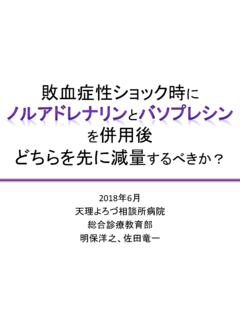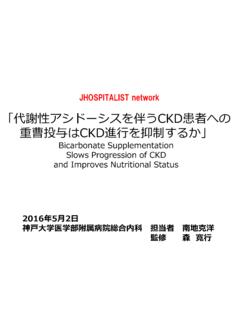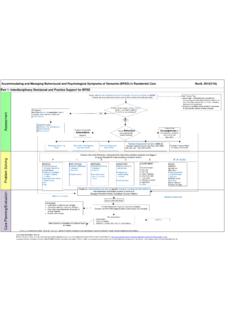Transcription of 「抑肝散は認知症のBPSDを改善するか」
1 JHOSPITALIST network BPSD Randomized double-blind placebo-controlled mul3center trial of Yokukansan for neuropsychiatric symptoms in Alzheimer's disease. PMID 23359469 2016 4 3 PGY5 83 ( 5mg/day) MMSE 25/30 2P2X( ) 5mg/day first choice BPSD(Behavioral and Psycological Symptoms of dementia ) EBM 5 steps Step1 PICO Step2 Step3 Step4 Step5 Step1-4 Step1 PICO P: I : C: O.
2 BPSD Step2 (primary studies) PubMed Yokukansan and dementia and BPSD Alzheimer s disease 2011 7 2013 1 22 ( ) P: Alzheimer s disease I : C O BPSD ( NPI-Q ) BPSD BPSD(Behavioral and Psycological Symptoms of dementia ) ( ) BPSD ( 2011;48;195-204) (TJ-54) ( ) BPSD ( ) NPI-Q score NPI(Neurophychiatric Inventory) NPI 1994 Cummings BPSD 10-15 (1 4 ) (1 3 ) 10 ( 1 120 BPSD (NPI-Brief Questionnaire Form) (Kaufer et al, J Neuropsychiatry Clin Neurosci 2000, 12.))
3 233-239) NPI-Q score 1 BPSD 12 (36 ) (60 ) / / / BPSD 60-70% (USA,UK) BPSD n 2005 RCT 52 NPI *11 J Clin Psychiatry 2005; 66: 248 252. n 2009 RCT 106 NPI *12 Int J Neuropsychopharmacol 2009; 12: 191 199. n 2013 RCT meta 4 RCT( 236 ) NPI ADL *18 Hum Psychopharmacol 2013; 28: 80 86.
4 BPSD BPSD Inclusion criteria 55-84 NPI-Q NPI-Q subcategory ( ) MMSE 10-26 ( 26-21 / 20-10 10- ) Exclusion criteria 1 2 BPSD ( ) Intervention 3 ( ) 1 2 (5g/day) Comparison 4 placebo placebo(Double-blind period) ( 3 ( ) Double-blind period(4 Week) Non-double-blind period(8 Week) 12 Week Placebo YKS YKS 4 Week 8 Week Outcome Primary Endpoint n 4 NPI-Q total score Outcome Secondary Endpoints NPI-Q total score NPI-Q subcategory score MMSE total score rescue drug (CTCAE ) - 12 12 IntroductionAlzheimer s disease (AD))
5 , an age-associated brain dis-order, is among the most common diseases causingdementia. Its first symptom is memory loss, whichbecomes more serious as the disease progresses in mostpatients with AD. Mental and behavioral disturbancesin the form of behavioral and psychological symptomsof dementia (BPSD), as defined by the InternationalPsychogeriatric Association in 1996, occur as a seriousand growing public health to theCache County Study on Memory in Aging (Utah, USA)in 2000, 61% of patients with dementia showed one ormore than 70% of patients with dementiain the UK have been reported to show areexacerbated by the situations and circumstances ofpatients with dementia , increasing caregiver burden,and the cost of 6 Conventional pharmacotherapies for BPSD usingtypical and atypical neuroleptics, antidepressants,anticonvulsants, hypnotics, and cholinesterase inhibi-tors target a wide spectrum of symptoms of ,8 However, their efficacy is limited, and these drugs causenumerous adverse reactions, such as cognitive impair-ment, somnolence, extrapyramidal symptoms and.
6 9,10 The US Food and Drug Administra-tion has warned that the mortality rate in elderlypatients with dementia was increased by the use oftypical and atypical neuroleptics (FDA Consum. 200539: 2 3). Alternative pharmacological interventions withgreater safety and efficacy should be required world-wide, given that BPSD vary from person to (YKS, TJ-54) is a traditional herbal medi-cine (Kampo medicine, granules) extracted from sevenmedicinal herbs (Atractylodes lancea rhizome,Poria sclero-tium,Cnidium rhizome,Uncaria hook,Japanese angelica root,Bupleurum root and Glycyrrhiza). YKS, which was originallyused to treat neurosis, insomnia, and irritability and/oragitation in infants, has been approved by the authoritiesin Japan as a prescription drug.
7 We first reported thatYKS improved BPSD in patients with AD, vasculardementia, dementia with Lewy bodies and other seniledementias in a randomized, observer-blind, controlledtrial in randomized controlled trials andopen-label trials of YKS showed a decrease in Neuropsy-chiatric Inventory (NPI) 15 One of our studiesshowed that YKS significantly improved NPI scores inAD patients taking donepezil,16and another study con-cluded that the dose of neuroleptics required to manageBPSD could be reduced by effects ofYKS on BPSD with almost no adverse reactions wereshown in a recent systematic review and meta-analysis ofrandomized controlled , to date, nodouble-blind, randomized, placebo-controlled studieshave been carried out, because it has been difficult todevelop an adequate placebo owing to the distinctivetaste and smell of YKS.
8 With success in placebo manu-facturing, we carried out a multicenter, randomized,double-blind, placebo-controlled clinical trial to deter-mine the efficacy and safety of YKS for the treatment ofBPSD in patients with design and overviewThe present study was a multicenter, randomized,double-blind placebo-controlled study of YKS inpatients with AD. The 12-week treatment period con-sisted of two terms: first a 4-week, double-blind periodto evaluate the effect of YKS on BPSD, and then an8-week, non-double-blind period mostly for safetyassessment. Although all the participants were admin-istered the active medicine in the non-double-blindperiod, they had not been informed when the 4-weekplacebo administration (the double-blind period) wouldbegin during the 12-week study present study was carried out in compliance withthe Helsinki Declaration and the study protocol.
9 A totalof 22 institutions throughout Japan participated in thetrial after obtaining approval from their local institutionalreview boards. Written informed consent to participatein this study was obtained from each participant or theirguardian. Legally authorized representatives and studyassistants carried out the efficacy evaluation. The datawere collected between June 2011 and January diagnosed with probable AD, as defined byDiagnostic and Statistical Manual of Mental Disorders,Third Edition, Revised, American Psychiatric Associa-tion, 1987 and National Institute of Neurological andCommunicative Disorders and Stroke and the Alzheim-er s Disease and Related Disorders Association(NINCDS-ADRDA) criteria, were eligible if they met allthe inclusion criteria included age 55 84years, total NPI Brief Questionnaire Form (NPI-Q)
10 Score greater than 4 points, the sum of NPI-Q subcat-egory scores for agitation/aggression and irritability/lability greater than 2 points, and Mini-Mental StateExamination (MMSE) score within the range of10 26 points. Individuals were excluded if they hadcerebral infarction possibly affecting cognitive function,major depression or bipolar disorder within the previ-ous year, or malignant tumor or other life-threateningdisease within the previous 2 years. Individuals werealso excluded if they had previously received YKS, or ifthey had received typical or atypical neuroleptics, tricy-clic or tetracyclic antidepressants, or Kampo medicineother than YKS within the previous 4 weeks.







